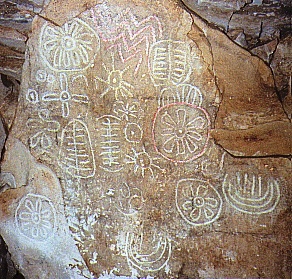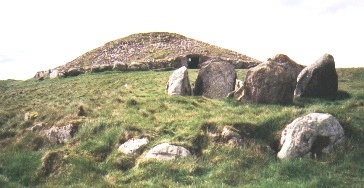
*The Stars and the Stones - Ancient Art and Astronomy in Ireland; Thames and Hudson, 1983; ISBN: 0-500-27283-2


Loughcrew is a Stone Age cemetery (c. 3200 BC) comprising some 30 passage tombs (like Newgrange) situated on a hill (Sliabh na Caillí - the Hill of the Hag) in northwest County Meath. Many of the tombs are in ruins, but we can enter one of the best-preserved ones, the tomb of Ollamh Fodhla, the poet-king who instituted the triennial feis at Tara in 1335 BC. The mound is known locally as "the witch's cave". I was told by a teenager -- who wouldn't go near the place -- that the witch will put a curse on you if you go inside. That doesn't stop people from gathering to celebrate sunrises, weddings, and whatever you're having yourself.

The tomb, labelled "Cairn T" by archaeologists, faces east, so that the rising sun at the Spring and Autumnal Equinoxes shines through the passage to illuminate sun symbols on a stone at the back of the chamber. The beam of sunlight is shaped by the upright and the sill stones in the passageway so that a bright rectangle moves diagonally across the stone as the sun rises, illuminating each of a series of sun symbols in turn. Video of sunbeam movement across the stone
As reported by Martin Brennan,* Cairn U, NE of Cairn T, has a stone bisected by a shadow at Summer Solstice, and its passage is aligned to 4 Feb and 8 Nov cross-quarter days, like the passage tomb at Tara. Cairn V, SE of Cairn T, marks the Winter Solstice. Y-shaped Cairn S, NW of Cairn T, marks sunsets on 6 May and 8 Aug cross-quarter days. A stone at Cairn N, SW of Cairn T, aligns on the Hill of Fore to mark the Winter Solstice sunset.
*The Stars and the Stones - Ancient Art and Astronomy in Ireland; Thames and Hudson, 1983; ISBN: 0-500-27283-2